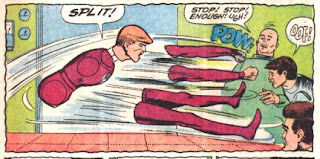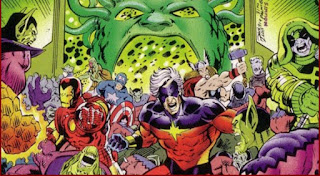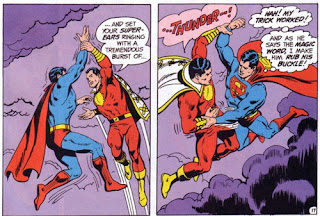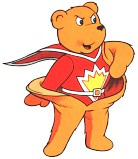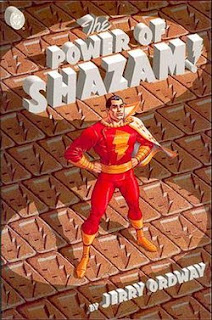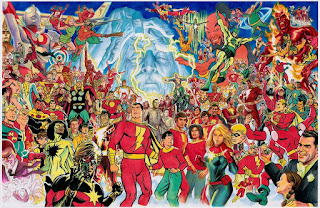Typical.
You wait ages for a Captain Marvel movie then two turn up at once.
I saw Marvel Studios' "Captain Marvel" a couple of weeks ago and before it started we were treated to the trailer for Warner Bros' upcoming movie "Shazam!", out Friday. I couldn't help but point out that Shazam was the original Captain Marvel.
Let me explain.
Let's go back to the beginning. And by the beginning, I mean issue #2.
The first character to be known as Captain Marvel appeared in Whiz Comics #2 in 1940.
Whiz Comics was published by Fawcett Comics. Fawcett was a publishing house founded in 1919 and was dipping its first toe into the fresh waters of Superhero comics.
Incidentally there was no Whiz Comics #1.
See, the whole genre of superheroes was only slightly over one year old. Superman had hit and had hit big. There was a positive gold rush among every publishing house to get their own superman.
Trouble was, it was such new genre that no one knew what superhero stories really were yet. As a result writers and artists were flailing around trying anything they could to see if it worked. Hence we got heroes with names like Mr Satan and The Press Guardian.
A personal favourite of mine is Red Bee. A wrongly-coloured bee-themed hero with a trained bee who lives in his belt. The bee is called Michael. I'm not making any of this up.
Anyway, so many comics were being published that didn't last beyond the first issue that cynical readers started avoiding issue #1, instead only buying something that had proven popular enough to get a second issue. Hence the first issue of Whiz Comics was issue #2. Quite clever of Fawcett. I did warn you this might get confusing.
Captain Marvel was created in 1939 by writer Bill Parker and artist C C Beck and was aimed at a younger audience than most other superhero comics.
The story concerns a homeless 12-year-old newsboy named Billy Batson who stumbles upon an ancient wizard while trying to sleep in the subway. The wizard is named Shazam and grants Billy powers of "the gods" (they aren't all gods) whenever he says the name.
It turns out Shazam is an acronym and gives Billy:
- The wisdom of Solomon
- The strength of Hercules
- The stamina of Atlas
- The power of Zeus
- The courage of Achilles
- The speed of Mercury
These manifest by putting Billy in the body of a full-grown, muscle-bound man in a red onesie with a cape.
The stories aimed at children combined with Beck's clean, simple, cartoonish style made Captain Marvel a big hit straight away. Plus children could relate to Billy more than any of the adult superheroes.
In fact Captain Marvel became so popular that the other publishing houses noticed and started marketing more towards children (Robin gets introduced to Batman later in 1940, for example).
And soon there were spin offs for Fawcett as the money rolled in.
Billy's friend Freddie Freeman became Captain Marvel Junior, Billy's long lost sister becomes Mary Marvel and then there was Uncle Marvel who... well that's a weird creepy story for another day...
And eventually (because of course) Hoppy the Marvel Bunny.
There is a charming simplicity to these stories that are delightful, especially when Otto Binder starts writing for them after Parker joined the army in October 1940. Viddy this rather literal representation of Captain Marvel versus the World:
Binder introduces a character that becomes Billy's best friend. A tiger in a suit called Mr Tawky Tawny.
Over the next few years the Marvel family get an impressive bunch of villains to battle, including CM's dark reflection Black Adam...
...archetypal evil scientist Dr Sivana...
...and Sabbac, who takes his powers from Satan, Any, Beelzebub, Belial, Asmodeus and Craetis...
To repeat in case you missed that HE TAKES POWER FROM SATAN!
And, of course one of the single greatest characters in any comic ever. Gentle reader, feast your eyes on the fearsome Mr Mind!
That's right. He's a tiny alien caterpillar who communicates through a radio set he wears round his neck. And he can control minds. He is the antagonist in a whopping 25-part story called The Monster Society of Evil in which he teams up with all CM's villains and ends with him being caught and sentenced to death. He gets the electric chair and his body is stuffed and put on public display.
Three things to note about that: First, stories aimed at children were a lot grimmer back then; Second, they had to create an electric chair for a caterpillar; Third, even after all that he still comes back in future stories.
Incidentally, some of you may have noticed something familiar about Captain Marvel's cape. And you are not wrong.
Elvis was a big fan of Captain Marvel.
Or, more accurately Captain Marvel Jr. The people who worked for him got given badges and more emblazoned with something close to the Marvel Family logo.
Captain Marvel gets popular in the 1940s. Very popular. He also becomes the first Superhero to make it to the movies.
By the 50s he is outselling Superman, unseating him as America's number one hero. So his publishing house, National Periodicals (later DC) does the only thing it can.
It sues.
And this where our story really starts.
The company that owned Superman (we'll call them DC) claimed that Captain Marvel infringed on their star and should cease and desist.
This is nonsense.
Captain Marvel's look, story, power set and storytelling style were sufficiently removed from Superman's that it was unlikely any reasonable court would find in DC's favour. And there were enough other superheroes out there that were brazen Superman knock-offs that it was decidedly fishy they went after Fawcett. Besides, Captain Marvel could fly before Superman could.
It seems that this was just DC trying to eliminate the competition. And it worked.
By 1953 Fawcett had lost so much money in legal fees that they gave up. They could not afford to keep publishing Captain Marvel comics. Or any other comics.
However that is not the end of our story. We will be seeing him again.
Captain Marvel also had a huge following in the UK. A publishing house called L Miller and Son, Ltd (snappy name) had been publishing black and white reprints of Captain Marvel and Captain Marvel Jr. They were popular and profitable. So when the stories stopped in 1953 they looked for replacements. British writers and artists were hired to... well, rip them off.
New stories arrived. Only Captain Marvel was now Marvelman and Captain Marvel Junior became Young Marvelman.
And this is where our story really starts.
Billy Batson is Micky Malone and his catchphrase "Holy Moley!" is now "Holy Macaroni!" and instead of saying "Shazam!" to change he says "Kimota!" (read it backwards).
Cos it's the 50s now and superpowers don't come from wizards, they come from nuclear power and radiation.
There's a Dr Sivana analogue in Dr Gargunza, too.
Though, sadly, I have not yet found a Mr Mind.
We don't get an origin of his powers and in the very first story his secret identity is discovered by shady foreign-type agents...
That's right, beat a child with an iron bar.
They take place in an America through the eyes of Brits in the 50s. There are some creative attempts at slang...
They are weird and charming in their own way but lack the craft of CM.
Oh, and remember how Captain Marvel debuted in Whiz #2? Well Marvelman debuted in Marvelman #25. This was because issues #1-#24 were titled Captain Marvel.
Marvelman continued to be published until 1959, when a change in UK law made American comics accessible and the sales dropped.
This is, however, not the last of Marvelman, either, we will be seeing more of him.
In the early 60s, of course, Stan Lee starts the Marvel age of superheroes, with Jack Kirby, Steve Ditko and the rest. The company formerly known as Timely and Magazine Management changed its name to Marvel Comics in 1961 and superheroes were back in a big way.
While there was not quite the gold rush there was in the Golden Age, a few new publishing houses cropped up to cash in. One such was M. F. Enterprises, whose owner, Myron Fass, had noticed that the name Captain Marvel was still available for use as the company that owned it no longer existed. So, in 1966, we get another Captain Marvel.
And this where our story really starts.
Yeah, this one's weird and slightly upsetting. This one is an alien android who can fire off the individual parts of his body with the magic word "Split!" then call them back by saying "Xam!"
I don't like it.
Make it stop!
Anyway, legal matters didn't really trouble MF as the comic featured characters called Plastic Man and Dr Fate (no relation to pre-existing characters owned by other companies) but it was this that finally prompted a letter from DC's lawyers:
Marvel Comics sued over the use of their company's name and received a settlement of $4,500.
There was no reason to worry though as the entire company lasted less than two years and this Captain Marvel ended in September 1967 having appeared in just six comics.
We won't be seeing him again.
However, Stan Lee sees the opportunity and immediately seizes the name Captain Marvel for, y'know, Marvel Comics.
And this is where our story really starts.
This Captain Marvel makes his début in Marvel Super-Heroes #12 in a story by Stan Lee and Gene Colan.
A member of the alien Kree race, Mar-Vell was a spy sent to Earth to gather information ahead of a possible invasion. His commanding officer, Colonel Yon Rogg and his love Medic Una are on board a ship orbiting the planet.
For reasons political and carnal Yon Rogg would prefer it if Mar Vell did not come back, so frequently sabotages his mission.
Meanwhile, on Earth, Mar Vell poses as a scientist at gets work at a US Air Force military base. It is there he meets Carol Danvers.
We haven't seen the last of her.
He finds himself gaining sympathy for the Earthlets, donning his Kree uniform to protect them from various threats with his super-strength and flight powers. The first time he does this he gives his name but is misheard and the name "Captain Marvel" sticks.
He finds himself drawn closer to Carol Danvers and their friendship is shown to Una by Yon Rogg to make her jealous.
There came a point when comics stopped throwing the word "holocaust" around so lightly...
The book doesn't really take off and when writer Roy Thomas and artist Gil Kane take over in issue #17 (Oct 1969) they change a lot.
In a story about Mar Vell preventing a plot by Ronan the Accuser to overthrow the Kree's ruler, The Supreme Intelligence, he is rewarded with a boosted power set and (thankfully) a much better costume.
Incidentally, Colan himself is on the record about how much he disliked his own original CM design.
Soon after, a story ends with CM accidentally trapped in the Negative Zone and only one person can help him: Marvel Comics' perennial sidekick, Rick Jones.
Rick has been around since 1962's The Incredible Hulk #1, where he stuck around as Bruce Banner's sidekick for some time before becoming the second Bucky, sidekick to Captain America. He'd later be sidekick to Rom: Spaceknight, but never mind that now.
He's very much between gigs when we join him in this story and an alien force guides him to an abandoned Kree base where he finds the negabands!
Long story short, they're magic bracelets that, when struck together enable Mar Vell to swap places with Rick, or vice versa.
So only one of them can exist on Earth at any time, the other must stay in the Negative Zone.
A young man carries out a ritual and becomes a full-grown Superhero. We are straying dangerously close to the original Captain Marvel again.
At one point CM is caught in a climactic battle with Yon Rogg in the presence of Carol Danvers (Medic Una having been fridged not long before). Danvers is injured in an explosion caused by a Kree device call the Psyche-Magnitron. After CM rescues her she does not return to this book.
We still haven't seen the last of her.
The revamp, however, was not enough. Sales were still low and Captain Marvel ceased regular publication. But, for legal reasons, Marvel Comics still had to produce Captain Marvel comics if they wished to hang on to the name.
Mar Vell became a key player in The Avengers' first major space story The Kree-Skrull War, also written by Roy Thomas. By this time Rick had found a way to free him from the Negative Zone so they could exist independently.
A new series is launched off the back of this, starting with Captain Marvel #22 (Sep 1972) but at issue #25 writer/artist Jim Starlin takes him on a new path.
It's Starlin who is known for building up the cosmic side of the Marvel Universe, creating epic space adventures with Adam Warlock, Thanos the Mad Titan, Drax the Destroyer and Gamora.
Starlin's stories have a strong cult following but again the sales aren't great. The series is eventually cancelled in 1979.
Unfinished stories by Starlin saw print in Marvel Spotlight (keeping that name on the cover) and eventually, in 1982, Captain Marvel did the one thing he is remembered for.
He died.
No, really. The Death of Captain Marvel is a true landmark in comics history.
It was the first graphic novel published by Marvel. And it's really good.
You might think of the deaths of superheroes you know about. The last desperate act that saves the world. Confronting the unbeatable foe. Giving a life so that others may live.
Mar Vell didn't get that.
He got cancer.
The Death of Captain Marvel is not your average superhero story. It mostly consists of characters reacting to watching their friend waste away. It's a slow, painful death and it really packs an emotional punch.

And that is the last we'll hear from him.
Now, however, Marvel Comics have a problem. Because they need to keep publishing Captain Marvel comics if they want to keep that name.
Why is that a problem, you may ask?
Let's go back to DC.
When Fawcett ceased it gave DC two advantages. It removed the competition and it enabled them to poach talent. Otto Binder's writing was put to work on Superman. He brought that child-friendly goofiness from Captain Marvel and gifted it to what we now know as the Silver Age Superman.
He gives us such mainstays as Supergirl, Bizarro, Brainiac, the bottled city of Kandor and, lest we forget, lion-head Superman.
I love this stuff.
I've seen it argued that those silver age Jimmy Olsen stories I love so much were from Binder writing Tawky Tawny stories but putting Superman's best friend in them instead of Billy's.
They do have the same taste in suits.
I'll also give a quick mention to a two-part story from Action Comics #272-273 wherein Supergirl meets Marvel Man.
And Binder sneakily writes a story featuring a godly-powered villain with the acronymic name Zha-vam!
That's four of the same gods from Shazam!
Then, in 1972, DC publisher Carmine Infantino went and got the rights to the actual original Captain Marvel.
However DC did not publish new Captain Marvel stories straight away. They tested whether there would be any interest by first inventing another CM analogue and dropping him into a Superman story.
Presenting: Captain Thunder!
He has a different emblem and all the names were changed, but this was Billy Batson, accidentally transported from another universe who gets into a misunderstanding that leads to a fight with Superman.
Reader reaction was positive so DC went ahead and published a new Captain Marvel comic in February 1973.
Except...
They can't call it Captain Marvel. Because of the other Captain Marvel. Mar Vell. Of Marvel Comics.
So instead...
The comic is titled Shazam!
With the subtitle "The Original Captain Marvel". Which they were forced to remove after another letter from Marvel Comics. Thereafter the cover referred to him as "The World's Mightiest Mortal".
It featured reprints of the original stories plus new stories, originally written by Dennis O'Neil and drawn by C C Beck, the co-creator of CM.
It was able to get some extra readers when a Saturday morning TV show called Shazam! airs on CBS between 1974 and 1976.
By this point it had been well-established that DC characters lived in a multiverse. Infinite Earths existed, separated by "vibrational frequency". So we are told that the Marvel family lived on "Earth-S" and we hadn't seen them in twenty years due to a terrible plot involving Dr Sivana and suspended animation.
Eventually, DC streamlined their multiverse, which was confusing for new readers, in their house-clearing Crisis on Infinite Earths. This ended with all their characters living on the same Earth and always having done so.
Now Captain Marvel, the Big Red Cheese, could interact with any of DC's other characters any time the writers wanted.
Owned by the very company responsible for killing him.
Let's check back in with Marvel Comics.
So, to hang on to the name Captain Marvel, now that Mar Vell was dead (and that was too powerful of story to simply undo) and there was a rival at the Distinguished Competition, they needed a new one.
Step forward Monica Rambeau.
This Captain Marvel got her powers from another pesky sciencey explosion and can convert her body to energy.
She debuted in The Amazing Spider-Man Annual #16 in 1982, by Roger Stern and John Romita Jr. Romita has stated that he based her look on Pam Grier.
Incidentally, this was the first Captain Marvel I knew, owing to her presence in Secret Wars, the first superhero comic I read regularly.
James Rhodes was Iron Man at this point, too, so I grew up with diversity in my superhero stories. Thanks for that, Marvel.
However, the character never really catches on, even though she ends up leading The Avengers.
The fact that she once lead The Avengers is something she apparently brings up all the time, according to Warren Ellis' brilliant superhero satire Nextwave.
She passes the name on to Mar Vell's son, Genis Vell, who becomes Marvel Comics' third Captain Marvel.
She took the name Photon until Genis Vell decides he wants that name too, before becoming Pulsar and then Spectrum.
Genis Vell first appeared in Silver Surfer Annual #6 (1993) before getting his own title in 1994 by Fabien Nicieza and Ed Benes, which (as I'm sure you won't be surprised to hear) doesn't sell well and is cancelled after six issues, with another six produced that remained unpublished.
Genis Vell's sister Phyla Vell took over the mantle in her own Captain Marvel mini-series in 2004 by Peter David and Paul Azaceta.
There was a Skrull sleeper agent called Khn'nr who appeared as Captain Marvel during Secret Invasion and the Kree hero Noh Varr, formerly known as Marvel Boy also briefly took up the mantle.
But what of the British comics?
The generation that grew up reading Marvelman were now superhero creators themselves. And there is something about the Captain Marvel model more than any other that keeps coming back.
For example, there is Thunderbolt Jaxon, a little boy who finds a magic belt that can transform him into an adult superhero.
Or Little Eric. When Eric eats a banana an amazing transformation occurs!
Or even Superted, who transforms by saying his magic words.
It always disturbed me how he took his outer skin off...
It's now the 1980s and UK comics editor Dez Skinn wants to bring Marvelman back.
He was putting together a new anthology comic in the style of 2000AD and Alan Moore desperately wanted to write it for him.
With art by Gary Leach, Marvelman debuted in Warrior #1 in 1982 in a very contemporary Britain.
And this is where our story really starts.
There is a central mystery as to what happened to the Marvelman characters, where they went 20 years ago. Mickey is an adult with a wife and a job and one day remembers he used to be a superhero. But it's when he finds his old sidekick Kid Marvelman that things take a dark turn.
Moore uses the trappings of superhero storytelling to weave a parable of politics and power and the nature of good and evil in that way he would later do with Watchmen.
The series ended on a cliffhanger in issue #21 (Aug 1984) possibly because of a legal threat from Marvel Comics (although it may have been due to arguments between Moore and Skinn) but Skinn had successfully licenced the character to American publishers, first Pacific Comics (which went out of business) then Eclipse Comics.
They reprint a newly-colourised version of Marvelman, in the standard US format, with each issue containing four "chapters" of the original.
Except...
They can't call it Marvelman.
You know, because Marvel Comics.
So instead the book and indeed the character are renamed Miracleman. Which is fine for contemporary readers but a bit of a shame for those who want to tie this character back the one from the 50s.
All the UK strips were reprinted in issues #1-#6, and after that Moore wrote new stories, continuing on with future X-Men artist Chuck Austen (under the name Chuck Beckum).
Moore and Austen are on the book until issue #16 when Neil Gaiman and Mark Buckingham take over on #17 (1990).
Eclipse comics, guess what, went bankrupt in 1994 and Miracleman ended, unresolved with issue #24. #25 was completed but has (as of time of writing) never been fully published.
In 1996 Todd McFarlane (the Richard Branson of comics) bought Eclipse's assets which was presumed to include Miracleman. However, this being a licenced, pre-existing character was not necessarily the case. Being Todd McFarlane he made merch anyway.
There is a long drawn-out legal process here that I don't fully understand but the key points are that Gaiman sued McFarlane in 2001 over ownership rights and that the courts ultimately decided that original creator Mick Angelo was the true owner of the rights in 2009.
Then, in a another twist, Marvel Comics stated that they wish to buy Marvelman/Miracleman that same year.
They managed to reprint "classic" Marvelman strips (yes he was Marvelman again) and eventually all the Moore run and about half the Gaiman.
Interestingly, because of an ongoing dispute between Moore and Marvel (and DC), Moore's name does not appear anywhere, the writing instead credited to "The Original Writer". Moore also donated all his royalties to Angelo.
The was also a "lost" story by Grant Morrison, written in the 80s but now illustrated by Joe Quesada and a new story by Peter Milligan and Mike Allred.
So, after many legal battles, Marvel now own Marvelman and DC own Captain Marvel.
So what of DC and their Captain Marvel?
Well, post-Crisis Cap gets a new origin story that fits in with the DC Universe in Shazam! The New Beginning written by Dann and Roy Thomas with art by Tom Mandrake. At the same time he gets a place in the Justice League during the well-respected series by Keith Giffen and J M DeMatteis.
However, as with Mar Vell, the Shazam titles don't take off particularly well. The four-issue mini-series sells quite decently and he gets a guest appearance in Action Comics (an anthology book at that time) in a story that re-introduces Golden-age villain Captain Nazi.
This was intended to start a new ongoing series but various attempts to do so failed to launch.
An original graphic novel called The Power of Shazam! by Jerry Ordway was published in 1994, retelling his origin. This was followed by a monthly series which started in 1995.
Issue #27 features a story in which time-travelling future hero Waverider shows Billy some potential alternate paths Captain Marvel could have taken...
Ordway there, having some fun. As well as Captain Thunder and Hoppy the Marvel Bunny you can see a "SPLIT!" version and a carefully non-infringing Rick Jones-alike.
After the mid-90s event "Marvel Vs DC" both universes got temporarily smooshed together as Amalgam. This featured Batman and Wolverine combined to form Dark Claw and Superman and Captain America making Super Soldier.
I only bring this up because the Amalgam comic JLX #1 features a character that is a combination of Billy Batson and Mar Vell called, appropriately enough, Captain Marvel.
The Power of Shazam! was eventually cancelled in 1999 and DC had made various attempts to start a new series but I believe the central child-like wholesomeness of the original Captain Marvel set it at odds with the increasing darkness of the DC Universe. It just wasn't a good fit.
The series Countdown, for example saw Mary Marvel (one of the purest, most innocent characters in comics) get corrupted by Darkseid. This got worse during Final Crisis.
And, before that in 52, the big bad behind a large part of the plot was Mr Mind, now in an evolved form that looked like this:
And that's to say nothing of the Big Red Cheese himself being the villain of 1996's possible future mini-series Kingdom Come.
If you want my opinion (and why wouldn't you?) the best DC-published Captain Marvel comics are Shazam! The Monster Society of Evil, by Jeff Smith (creator of Bone);
and Convergence: Shazam! by Jeff Parker and Evan "Doc" Shaner,
both of which stick to the formula and style of the childlike 40s stories.
By the time of the New 52 relaunch in 2012, DC gave up on Captain Marvel. They finally realised that no-one outside of comics fans knew he was even called Captain Marvel. The comic and the 70s TV show some still remembered were called Shazam, so surely that was his name.
So a back-up story in the re-launched Justice League (by Geoff Johns and Gary Frank) admits defeat and now he is called Shazam, relinquishing the name Captain Marvel at last.
This was at around the same time Marvel Comics launched their new Captain Marvel, to great critical and commercial success. Presenting the new Captain Marvel: Carol Danvers!
Remember her?
When last we met she was being hit by an exploding psyche-magnitron. In 1977 Gerry Conway brought a little taste of the "women's lib" revolution to Marvel Comics. He'd been resonsible for co-creating Power Girl for DC just a year earlier who also wore her feminism on her sleeve.
To be fair Marvel had always pushed for equality. Go back and have a look at the panel of her first appearance in 1968. Carol is not only the head of security at a military base; "man or woman she's the finest head of security a military base could want!"
Like a lot of attempts at politically aware comics of the 70s written by straight white men, one can file some of it under "They meant well".
Ms. Marvel #1 by Conway and John Romita (Jan 77) gives us our first look at Carol Danvers' new superhuman persona. And that "Ms." is a well-chosen feminist moniker. No "Marvel Girl" she.
It turns out that when a psyche-magnitron explodes on you, you get Kree-like superpowers. That's just science.
Danvers had been discharged from the military and wrote a best-selling whistle-blowing expose of NASA. But now she is working in New York city for jolly old J. Jonah Jameson, editing the Bugle-published magazine "Woman".
Conway left the book after just two issues, leaving future comics superstar Chris Claremont to take over. Sales, once again, aren't great, so by issue #19 Claremont decides to take the book in a different direction.
Ms. Marvel meets Captain Marvel for the first time since that explosion with Yon Rogg, as Mar Vell once again finds himself accused by the Kree Supreme Intelligence. Carol gets involved to help an old friend and is taken captive by Ronan the Accuser along with him.
Long story short, she saves the day, gets caught in another Kree device, gets a new power set and, come next issue, a new costume.
However, low sales once again scuppers the run and Ms. Marvel is cancelled after 23 issues.
However, during that time Claremont has created various characters, including Rogue and Mystique, that he would go on to use in his All New All Different X-Men. Rogue, indeed, acquired her super strength and flight ability by absorbing them from Carol.
And Ms. Marvel found herself appearing in The Avengers and occasional other Marvel titles where she gets treated pretty appallingly.
It starts with Avengers #200 by David Micheline and Jim Shooter, wherein the team come back to Avengers Mansion to find a heavily pregnant Carol Danvers.
The problem being this should be impossible, in spite of how happy her friends are for her.
The gestation is rapid and the child, once born, grows quickly to adulthood. And the explanation ain't great.
Nutshell version: A being called Marcus, trapped in another dimension, found a way to escape by using Carol's womb.
He used psychic technology to seduce Carol and, well... impregnate her with himself.
The whole thing is really icky and when Carol decides to travel to another dimension with her new lover/son to start a new life all the Avengers are thrilled for her. I won't go into it in any more detail here but if you want to read more, here is an excellent essay by Carol A Strickland.
Anyway, this story so infuriated Chris Claremont that when he got the chance to write Avengers Annual #10 he had Ms. Marvel return to voice his complaints. Carol has escaped back to Earth, Marcus having died of accelerated old age, and she is pissed at the Avengers.
She slaps Thor and makes her point about them abandoning her.
Not surprisingly, Carol takes this opportunity to leave Earth with the X-Men and have some adventures in space, in spite of Rogue, who was created as a Ms. Marvel villain, now being on the team.
Readers of a certain age may remember the episode of X-Men: The Animated Series wherein we learn of Rogue's back story and see a comatose Ms. Marvel.
Anyway, Carol flies off with the X-Men to help the Shi'ar, before being captured by the Brood and experimented on. However her Kree blood confuses them and they end up changing her power set again.
She changes her name to Binary and has space adventures for a bit (like the Captain Marvel movie) before coming back to Earth after a considerable absence. This leads to an awkward moment when she drops in on Avengers mansion and is introduced to... er... Captain Marvel...
Yeah, no-one thought to tell her...
Over the next decade or so she gets depowered back to Ms. Marvel level, takes on the name Warbird, becomes an alcoholic and is suspended from the Avengers for being drunk on duty.
You can't keep Carol down, though, and she overcomes her personal problems, becomes an asset during Civil War and eventually becomes leader of the Avengers.
Other stuff happens, but let's skip to July 2012, when a new Captain Marvel series is launched by Kelly Sue DeConnick and Dexter Soy.
Following a battle with Absorbing Man, Captain America suggests she takes on the name of Captain.
She does and a new Captain Marvel enters the Marvel Universe. A Captain Marvel both popular and critically acclaimed.
She has more space adventures, meets with Rocket and finds a cat flerken.
She makes some weirdly out-of-character mistakes in Civil War II (which I'll cover some other time) and that brings us near enough to now that I'll stop.
There are other characters named Marvel (other Ms. Marvels and Marvel Boys for example) but I think I've wasted enough of your time.
Captain Marvel. Splendid chaps. All of them.
(I mean apart from that "Split!" one, he was just weird.)
And just yesterday, Alex Ross released a piece of art featuring all the characters inspired by the original Captain Marvel he could think of. Including some I hadn't thought of before (Ultraman, He-Man...).
Have fun with this.




























